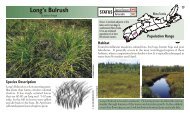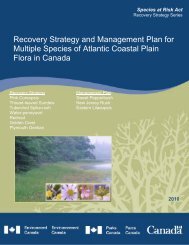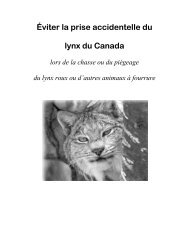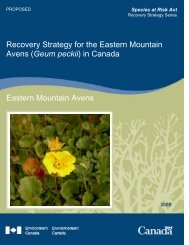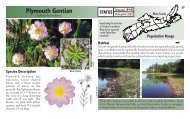Healthy Lakes and Wetlands For Tomorrow - Species at Risk
Healthy Lakes and Wetlands For Tomorrow - Species at Risk
Healthy Lakes and Wetlands For Tomorrow - Species at Risk
Create successful ePaper yourself
Turn your PDF publications into a flip-book with our unique Google optimized e-Paper software.
AGRICULTURAL PRACTICES<br />
Agricultural l<strong>and</strong>s are a vital part of our l<strong>and</strong>scape <strong>and</strong> provide us with fresh, local food.<br />
However, agricultural practices can impact w<strong>at</strong>er quality <strong>and</strong> wildlife habit<strong>at</strong>. There are many<br />
beneficial practices th<strong>at</strong> farmers can adopt to ensure th<strong>at</strong> the l<strong>and</strong> <strong>and</strong> w<strong>at</strong>er resources<br />
near the farm are healthy. Below are some practices th<strong>at</strong> can be easily incorpor<strong>at</strong>ed into<br />
the farm oper<strong>at</strong>ion to benefit both the farm <strong>and</strong> its associ<strong>at</strong>ed wildlife.<br />
Short-Eared Owl<br />
Re-establish or maintain the n<strong>at</strong>ural veget<strong>at</strong>ion<br />
around all w<strong>at</strong>er bodies.<br />
A riparian zone is the l<strong>and</strong> next to streams, rivers, lakes, ponds,<br />
<strong>and</strong> wetl<strong>and</strong>s. Veget<strong>at</strong>ed riparian zones with trees <strong>and</strong> shrubs<br />
benefit both the farm oper<strong>at</strong>ion <strong>and</strong> wildlife habit<strong>at</strong>. Farm<br />
activities, l<strong>and</strong> topography (including slope), <strong>and</strong> soil type all play a role in the width of veget<strong>at</strong>ion th<strong>at</strong><br />
is required. Any width provides some benefits but <strong>at</strong> least 30 m (100 feet) is ideal.<br />
Eastern Ribbonsnake<br />
43<br />
Do not infill or alter the wetl<strong>and</strong>s on your property.<br />
Historical l<strong>and</strong> practices often promoted the infilling of wetl<strong>and</strong>s to the detriment of many species. We now<br />
recognize the vital ecosystem functions th<strong>at</strong> wetl<strong>and</strong>s provide, <strong>and</strong> th<strong>at</strong> they represent unique habit<strong>at</strong> for<br />
many wildlife species. Any wetl<strong>and</strong> alter<strong>at</strong>ion requires approval from Nova Scotia Environment.<br />
Reduce or elimin<strong>at</strong>e pesticide, herbicide, <strong>and</strong> chemical fertilizer use.<br />
Crop rot<strong>at</strong>ion <strong>and</strong> planting autumn cover crops can reduce soil erosion <strong>and</strong> the need for pesticides,<br />
herbicides, <strong>and</strong> chemical fertilizers. If you choose to apply chemicals, ensure th<strong>at</strong> you do so <strong>at</strong> least 30<br />
m (100 feet) away from w<strong>at</strong>er sources <strong>and</strong> wetl<strong>and</strong>s <strong>and</strong> do not spray before a rain event or in windy<br />
conditions. This will reduce the effects of pesticide runoff <strong>and</strong> drift.<br />
Ensure th<strong>at</strong> your fertilizers, chemicals, <strong>and</strong> fuels are properly stored in a contained<br />
area well away from wetl<strong>and</strong>s <strong>and</strong> w<strong>at</strong>er bodies.<br />
This will ensure they do not contamin<strong>at</strong>e surface or ground w<strong>at</strong>er. Contact the Environmental Farm Plan<br />
program for current guidelines (902-893-2293).<br />
Plough or till across a slope (with the contour) instead of up <strong>and</strong> down.<br />
Each furrow acts as a barrier to slow overl<strong>and</strong> runoff <strong>and</strong> soil erosion. Avoid ploughing in the fall, which<br />
will result in soil erosion during the winter. If ploughing must be done, plant a cover crop to prevent<br />
erosion during the winter months.




